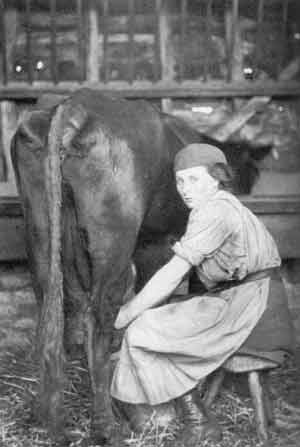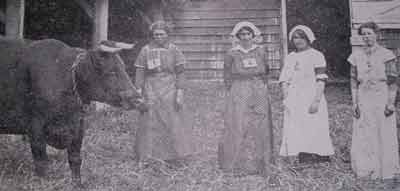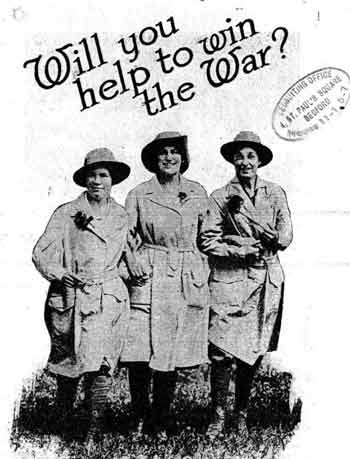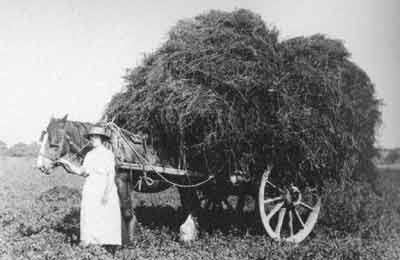Bedfordshire's Women's Land Army During the First World War
The Women's Land Army (WLA) - the National Organisation > The First World War
This article first appeared (in two parts) in the Spring 2010 [Vol 5, No 3] and Summer 2010 [Vol 5, No 4] issues of History in Bedfordshire (the newsletter of the Bedfordshire Local History Association).
STUART ANTROBUS who has written the definitive history, We wouldn't have missed it for the World: the Women's Land Army, 1939–1950 (Book Castle Publishing, 2008), here turns his attention to the First World War. His website Bedfordshire Women's Land Army, hosted by Bedfordshire Virtual Library, currently attracts over 130,000 hits per year and a total of over 750,000 million hits since 2002.
Urgent labour needs in Britain during the First World War (1914–18) led to a revolution in the role of women in the workplace. The fact that millions of men had been drawn out of production into the armed forces, plus the need for armaments to feed industrial-scale warfare, led to women being drawn into factories and especially to munitions production. By the end of 1916, food shortages, thanks to the enemy's blockading of merchant shipping including food imports from the Empire, plus a shortage of male labour on farms, brought about a call to women to partially replace or supplement the work of men in the fields.
After Lloyd George became the Prime Minister in December 1916, a new Food Production Department was set up and Rowland Prothero, MP, formerly the Duke of Bedford's chief Land Agent, was appointed President of the Board of Agriculture (until September 1919). This led to a more interventionist but de-centralised system of direction to farmers through the locally established War Agricultural Committees (formed in the autumn of 1915), to replace the laissez-faire farm policy of the past. One major initiative was the establishment of a so-called Women's Land Army (WLA) of voluntary but paid mobile female workers organised under Meriel Talbot, a senior civil servant who was appointed Director of a new Women's Branch of the Board of Agriculture. Able-bodied women aged 18 years and over, with the consent of their parents, were to be recruited, trained for six weeks and offered to farmers to assist with milking, care of animals and work in the fields.
However, getting inexperienced women to take the place of men was no easy task. First, farmers were prejudiced and innately conservative with regard to women's roles in farming and were reluctant to take them on. Traditionally, women were limited to tasks in the dairy, looking after hens or tending to young livestock such as lambs, and this work was taken on mainly by members of the farmer's family. Only at harvest time was this opened up to farm labourers' wives and older children to do field work such as potato-picking or stooking the corn.
Secondly, persuading women who had not previously worked on the land was not easy, since the status of a woman land worker was seen as socially inferior to that of the domestic servant and was poorly paid. And, even if a woman was inclined to do her bit for the country when at war, the practicalities of finding suitable clothes and footwear were considerable in terms of cost and would certainly inhibit recruitment for anyone other than the well-off who would not be so inclined anyway. Yet the Government had initially targeted middle-class urban women since they believed they needed 'the right type of women who would create a favourable impression on the farming community'.
Bedfordshire Women's War Agricultural Committee first met on 26 February 1916 (as an off-shoot of Bedfordshire War Agricultural Committee). Its Executive Committee chairman was Mrs Madeline Whitbread of Southill Park and Mrs Nora Whitchurch of Great Barford House, Sandy, the secretary, and it had regular meetings at Shire Hall, Bedford. Sub-committees took responsibility for Finance, Training and Hostels, Central Selection and Allocation of Workers, Luton Selection and Allocation, and Women's Institute propaganda to support recruitment. In June 1917, Miss H M Dymock of Bedford, an organising secretary appointed by the Board of Agriculture, opened an office at 15A St Paul's Square, Bedford.
The county map had been already divided into 14 districts by Mr Trustram Eve, Chairman of the Bedfordshire War Agricultural Committee, and now suitable women district representatives were recommended by county councillors and appointed by the Board of Agriculture. These were to be the people to whom farmers applied for women to work on the land and were also responsible, in turn, for appointing volunteer 'village representatives' who would register all local women farm workers.

Kathleen Hull milking at Bridge Farm, Great Barford c1914
BLARS Slide 5175
A Women's National Land Service Corps (WNLSC) had been established, nationally and women were encouraged to sign on at Labour Exchanges but local initiatives were seen as more likely to be successful. Meetings were arranged to 'rouse interest'. Demonstrations and competitions in women's farm work, including milking, handling and management of horses and calves, driving stock, ploughing, hoeing corn, weeding and setting out roots, were held at Mr Anthony Chibnall's farm at Biddenham on 8 June 1916.
Most of the Land Army women employed as volunteers on Bedfordshire farms were members of the Land Army Agricultural sections (LAAS), as opposed to the other two sections, or divisions, dealing with forage (providing food for soldiers' horses) and timber cutting. They signed up for either six months or for a year. By March 1917 pay was 18 shillings (90p) per week and, later, 20 shillings (£1), once Efficiency Tests were passed, with different rates of pay for haytime and harvest. Arrangements were made for two or more women to work together to encourage participation. In 1919 some women were earning 25s to 30s (£1.25–£1.50) per week, which was still low pay compared with that of other industries. This was for nine- or ten-hour days, six days a week, of hard work, normally starting before dawn.
Schemes for instruction of women in 'light farm work' were developed, requiring 6 weeks' experience on approved farms (eventually there were 25 such farms in Bedfordshire), with daily attendance. A maximum fee of 5 shillings (25p) per month was offered to cowmen and foremen who instructed women on these practice farms during the training period. Dairy training began by teaching milking skills 'on the artificial cow'. Free uniform work clothing was provided to these recruits by the committee. It consisted of boots, gaiters, clogs, overall, breeches, hat, jersey and mackintosh. Farmers were allowed to retain these trainees after training, at their own expense, if they wished. So-called 'practice farms', prepared to train women workers, included those of Mr Alfred Inskip of Shefford and Mr Herbert Inskip at Stanfordbury Farm; Mr Hale in Clifton; Mr Abliss at Woburn; Mr Kestell at Heath and Reach, near Leighton Buzzard; Mr Alington in Little Barford and Mr Ernest Frossell of Box End; the Duchess of Bedford at Woburn. Names of other farmers who provided reports on women in training to the committee included Mr H King, Mr Kestell, Mrs Kendal, and a Mr Tipton. A Reverend E Blackherne of Bolnhurst offered to provide training to women on driving the new motor tractors and advertisements for women volunteers for motor tractor work were put in local papers and in the Labour Exchange in Bedford.

Milkmaids: Misses K Hull, Great Barford; Annie Brown, Hinwick; Eva Smith, Great Brickhill; and May Hull, in a demonstration of milking at Mr Chibnall's Homestead, Biddenham, June 1916. (BLARS WW1/WA5/2/4)
By 29 April 1916 about 140 women in Bedfordshire had registered for work on the land and about 30 of them were undergoing training under a County Council Education Committee Scheme. By 27 May there were 260 women registered under the scheme, in addition to 682 unregistered already working on the land in the county. Green baize armlets bearing a red crown were issued to registered workers to identify them as committed to the war effort. A certificate emblazoned with the Royal Coat of Arms in colour was issued, carrying the following patriotic text: 'Every woman who helps in agriculture during the war is as truly serving her country as the man who is fighting in the trenches, on the sea, or in the air.'
A lapel badge was issued after two months of approved service. Not all those registered found farms prepared to employ them but members who were employed were awarded Good Service stripes for their armbands by District Registrars after each six months of satisfactory work. Four of these stripes could be exchanged for a diamond. The land girls even had their own songs with stirring lines:
'There are many women's armies, but none do work so grand
As they plough and sow and reap and mow – our Women on the Land.'
By 19 October 1917 returns from the district Registrars revealed that there were 899 part-time women workers on Bedfordshire farms and 496 full-time workers and a proportion of these were women employed under the Land Army scheme. A Junior Section of the Women's Land Army was announced that month for girls between the ages of 16 and 18 years. In time, as Land Army gangs were established for specific tasks, group leaders were appointed from the land girls.
Accommodation for women agricultural workers was not always possible on the farms where they worked and there was also a need to accommodate mobile gangs of female workers, so hostels were set up. Hostels were opened at a number of locations over the next two years, including: at a farmhouse in Cotton End, Bedford, owned by the County War Agricultural Committee; at Wren Park, Shefford, which accommodated 40 women; at Bourne End, Bletsoe; one in Toddington; and at Cooter's End on the Luton Hoo Estate, near Luton, for 16 women who worked on Lady Wernher's Home Farm. There was a Timber Department hostel at Clophill.
For those women who needed billets when changing from one farm to another and temporarily out of work, there were two hostels in Bedford, one run by the YWCA and the other by the Girls' Friendly Society at 3 Warwick Avenue, Bedford. A Land Service Corps gang hostel was established at Slip End and in May 1918 Wren Park offered itself as a hostel for 'potato gangs' of mobile women workers. Mrs Skinner was the Matron there and a cook-general lived in.

(Will you help win the war? Recruiting leaflet, c1917. BLARS WW1/WA5/1/1)
In March 1917, two representatives from the committee were asked to attend a meeting of the Women's National Service Scheme at the Albert Hall, London, to demonstrate what had been achieved. But when the county was invited to provide 11 women land workers to take part in the Lord Mayor's Show on 9 November 1917, the county committee was opposed to the proposal on the grounds that farmers were behind in their work due to the bad weather.
In July 1917 it was agreed that women might be employed on wet days, if willing, on such work as cleaning out barns, cleaning harness, mending sacks and picking over fruit, but not purely domestic tasks unconnected with agriculture.
Head lice could be a problem with some women workers and in August 1917 medical practitioners were asked to state clearly on medical certificates whether girls' heads were clean. Selection committees were asked to reject volunteers until passed clean. Dr Stacey had recommended that National Service volunteers should have their hair cut short as a preventive measure.
To help make life more tolerable for women farm workers billeted away from home, a scheme was established to provide library books and advertisements were put in local newspapers requesting gifts of suitable books for Landworkers' Libraries to be set up. Similarly, 55 National Service workers were invited to a Christmas treat of entertainment on 1 January 1918 by the Girls' Friendly Society in Bedford. A monthly magazine, The Landswoman, was published from 1918 onwards.
Complaints from women workers as to the long hours they had to keep as milkers prompted the committee to approach farmers as to whether some curtailment of the afternoon's work might be possible. In June 1918, the county committee applied to the Board of Agriculture for permission to hire or purchase bicycles for women workers because of the distance some had to travel from their hostels to their farms. Extra blankets were requested in cold weather for young women in the hostels. Mrs Peacock of Bromham acted as Honorary Welfare Officer for some time.

Carrie Partridge with hay cart at Town Farm, Riseley,
c1916-1919
BLARS Z50/96/37
Another important allied development which led to improvements in the lives of women generally in the countryside was the setting up of new Women's Institutes (WIs) in villages, under the auspices of the Board of Agriculture, following the lecture by Mrs Madge Watt on the success of such organisations in Canada and the piloting of several in England and Wales. The Bedfordshire Women's Agricultural Committee approved the idea and decided to enquire of other neighbouring counties as to what they were doing to establish WIs. The first WI in Bedfordshire in 1917, was, ironically, in the town of Dunstable but was closely followed by the villages of Dean and Bletsoe. Early branches focused on war aims such as replacing men on the land, being self-sufficient in food, maintaining village industries and, what later became the iconic image of WIs, jam-making. Mrs Whitbread became the first County Chairman and Mrs Whitchurch the Vice-Chairman, when the Bedfordshire Federation of WIs was formed in September 1919. The secretary was Miss Foster of Wootton.
In 1918 Efficiency Tests for land girls were begun nationally, with examiners selected from the areas where the training centres were. Mr J H Brown, Mr H Humphries and Mr Ernest Frossell acted as Honorary Examiners in Bedfordshire in conjunction with Board of Agriculture officials. Tests included horsework, ploughing, weeding, care of stock and milking. The first ones in Bedfordshire took place on 23 April 1918, highlighting the skills that women farm workers in the county could demonstrate. Cooter's End training centre was one of the places in the south of the county, near Luton Hoo, where Efficiency Tests were held.
The Great War, as it had been known, ended with the Armistice in November 1918 but women continued to work on the land until men eventually returned after demobilisation in 1919. Land girls took part in the Peace Celebrations of 19 July 1919 at Luton, Dunstable and Bedford. Two Bedfordshire land girls, Tamar Reade and Kate Watts, represented the county at a national rally in London on 27 November and the Women's Land Army was disbanded on 30 November 1919 (not to be revived until June 1939 after which, eventually, over 200,000 young women were to do vital work in food production during and just after the Second World War). A farewell party for Bedfordshire women farm workers was held at Dudeney and Johnston's in Bedford on the afternoon of 28 November 1919. Members were allowed to keep their hat and badge after the disbandment. Bedfordshire's Women's War Agricultural Committee office was closed and the committee disbanded early in 1920.
Nationally, some 23,000 women were trained up and took up farm work during the First World War and at any one time during its peak the WLA had a strength of 16,000 members, doing what had previously been seen as men's work on Britain's farms between 1916 and 1919. Most were milkers and field workers but a smaller number were carters, early tractor drivers, 'ploughmen', thatchers, shepherds and in horticulture. Inevitably, some were lured away by higher wages in factories and had to be replaced. The harvest of 1918 was the peak of wartime food production, with almost 2m tonnes of wheat and 3m tonnes of potatoes above the 1916 tonnage achieved.
In Bedfordshire, during the three years existence of the Land Army, some 90 farmers applied for women workers and 550 Land Army members worked, for various periods of time, as registered farm workers, including 150 women who had been trained in the county and others who had received training elsewhere. On demobilisation, 60 land girls in Bedfordshire expressed a wish to stay on the land, if they could, and 44 of these were asked by their employers to stay as permanent workers on their farms.
Meriel Talbot, writing in the last official issue of The Landswoman, following the disbandment of the WLA, wrote with gratitude of 'the opportunity for service it has given us, for the manifold experience gained, and for the door opened to women to take their place in the agricultural life of the country'. The appearance of women in trousers, breeches and puttees in villages throughout Britain had brought a real, if temporary, transformation in the image of women. Regrettably, however, the same prejudices against the employment of women on the land which were met at the beginning of the First World War were to be met again, 20 years later, at the beginning of the Second World War.
Sources and further reading
- Bedfordshire Archives, Bedford (BLARS): WW1/WA1, WW1/WA3, WW1/WA4, WW1/WA5, WWA/6/2, PK8/1.
- Gill Clarke, The Women's Land Army: A Portrait (2008)
- Carol Twinch, Women on the Land: Their Story during Two World Wars (1990)
- Bonnie White, The Women's Land Army in First World War Britain (2014)
Find out more about the Women's Land army in England and Wales during the First World War
Find out about the Women's Land Army During and After the Second World War
Stuart Antrobus Historian/Author
Page last updated: 13th October 2016

